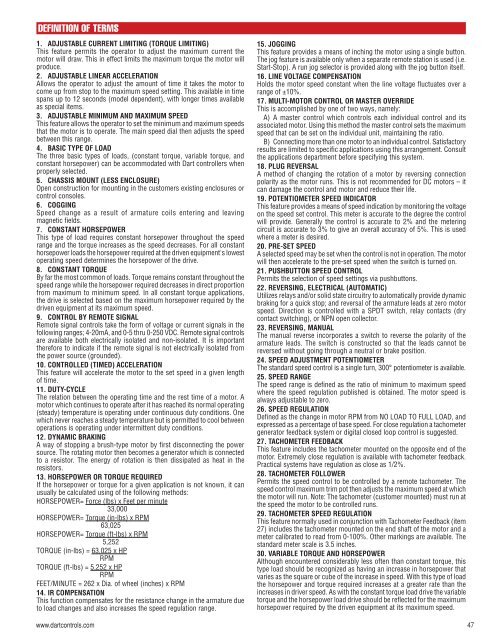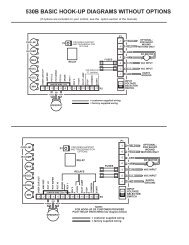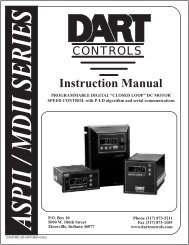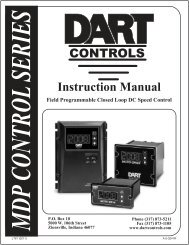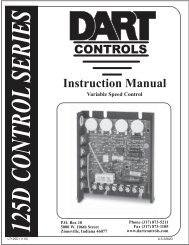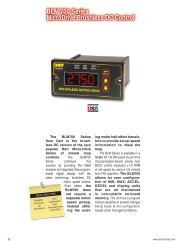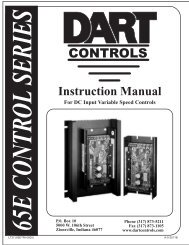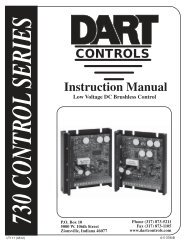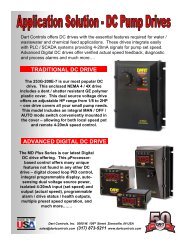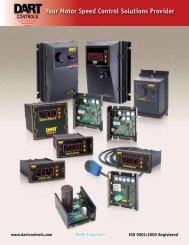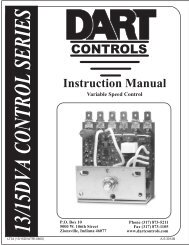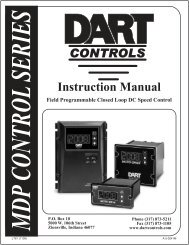Darrtt Controls Full Linnee Catalog - Dart Controls
Darrtt Controls Full Linnee Catalog - Dart Controls
Darrtt Controls Full Linnee Catalog - Dart Controls
Create successful ePaper yourself
Turn your PDF publications into a flip-book with our unique Google optimized e-Paper software.
DEFINITION OF TERMS<br />
1. ADJUSTABLE CURRENT LIMITING (TORQUE LIMITING)<br />
<br />
<br />
produce.<br />
2. ADJUSTABLE LINEAR ACCELERATION<br />
Allows the operator to adjust the amount of time it takes the motor to<br />
<br />
spans up to 12 seconds (model dependent), with longer times available<br />
as special items.<br />
3. ADJUSTABLE MINIMUM AND MAXIMUM SPEED<br />
<br />
that the motor is to operate. The main speed dial then adjusts the speed<br />
between this range.<br />
4. BASIC TYPE OF LOAD<br />
The three basic types of loads, (constant torque, variable torque, and<br />
constant horsepower) can be accommodated with <strong>Dart</strong> controllers when<br />
properly selected.<br />
5. CHASSIS MOUNT (LESS ENCLOSURE)<br />
<br />
control consoles.<br />
6. COGGING<br />
Speed change as a result of armature coils entering and leaving<br />
<br />
7. CONSTANT HORSEPOWER<br />
This type of load requires constant horsepower throughout the speed<br />
range and the torque increases as the speed decreases. For all constant<br />
<br />
operating speed determines the horsepower of the drive.<br />
8. CONSTANT TORQUE<br />
By far the most common of loads. Torque remains constant throughout the<br />
speed range while the horsepower required decreases in direct proportion<br />
<br />
<br />
<br />
9. CONTROL BY REMOTE SIGNAL<br />
Remote signal controls take the form of voltage or current signals in the<br />
<br />
<br />
therefore to indicate if the remote signal is not electrically isolated from<br />
the power source (grounded).<br />
10. CONTROLLED (TIMED) ACCELERATION<br />
This feature will accelerate the motor to the set speed in a given length<br />
of time.<br />
11. DUTY-CYCLE<br />
The relation between the operating time and the rest time of a motor. A<br />
motor which continues to operate after it has reached its normal operating<br />
(steady) temperature is operating under continuous duty conditions. One<br />
which never reaches a steady temperature but is permitted to cool between<br />
operations is operating under intermittent duty conditions.<br />
12. DYNAMIC BRAKING<br />
<br />
source. The rotating motor then becomes a generator which is connected<br />
to a resistor. The energy of rotation is then dissipated as heat in the<br />
resistors.<br />
13. HORSEPOWER OR TORQUE REQUIRED<br />
If the horsepower or torque for a given application is not known, it can<br />
<br />
<br />
33,000<br />
<br />
63,025<br />
<br />
5,252<br />
<br />
RPM<br />
<br />
RPM<br />
<br />
14. IR COMPENSATION<br />
This function compensates for the resistance change in the armature due<br />
to load changes and also increases the speed regulation range.<br />
www.dartcontrols.com<br />
15. JOGGING<br />
This feature provides a means of inching the motor using a single button.<br />
The jog feature is available only when a separate remote station is used (i.e.<br />
<br />
16. LINE VOLTAGE COMPENSATION<br />
Holds the motor speed constant when the line voltage fluctuates over a<br />
<br />
17. MULTI-MOTOR CONTROL OR MASTER OVERRIDE<br />
<br />
A) A master control which controls each individual control and its<br />
<br />
speed that can be set on the individual unit, maintaining the ratio.<br />
B) Connecting more than one motor to an individual control. Satisfactory<br />
<br />
the applications department before specifying this system.<br />
18. PLUG REVERSAL<br />
A method of changing the rotation of a motor by reversing connection<br />
polarity as the motor runs. This is not recommended for DC motors – it<br />
can damage the control and motor and reduce their life.<br />
19. POTENTIOMETER SPEED INDICATOR<br />
This feature provides a means of speed indication by monitoring the voltage<br />
on the speed set control. This meter is accurate to the degree the control<br />
<br />
<br />
where a meter is desired.<br />
20. PRE-SET SPEED<br />
A selected speed may be set when the control is not in operation. The motor<br />
<br />
21. PUSHBUTTON SPEED CONTROL<br />
Permits the selection of speed settings via pushbuttons.<br />
22. REVERSING, ELECTRICAL (AUTOMATIC)<br />
<br />
<br />
speed. Direction is controlled with a SPDT switch, relay contacts (dry<br />
contact switching), or NPN open collector.<br />
23. REVERSING, MANUAL<br />
The manual reverse incorporates a switch to reverse the polarity of the<br />
armature leads. The switch is constructed so that the leads cannot be<br />
reversed without going through a neutral or brake position.<br />
24. SPEED ADJUSTMENT POTENTIOMETER<br />
<br />
25. SPEED RANGE<br />
<br />
where the speed regulation published is obtained. The motor speed is<br />
<br />
26. SPEED REGULATION<br />
<br />
<br />
generator feedback system or digital closed loop control is suggested.<br />
27. TACHOMETER FEEDBACK<br />
This feature includes the tachometer mounted on the opposite end of the<br />
<br />
<br />
28. TACHOMETER FOLLOWER<br />
Permits the speed control to be controlled by a remote tachometer. The<br />
<br />
<br />
the speed the motor to be controlled runs.<br />
29. TACHOMETER SPEED REGULATION<br />
This feature normally used in conjunction with Tachometer Feedback (item<br />
27) includes the tachometer mounted on the end shaft of the motor and a<br />
<br />
standard meter scale is 3.5 inches.<br />
30. VARIABLE TORQUE AND HORSEPOWER<br />
Although encountered considerably less often than constant torque, this<br />
<br />
<br />
the horsepower and torque required increases at a greater rate than the<br />
increases in driver speed. As with the constant torque load drive the variable<br />
<br />
<br />
47


